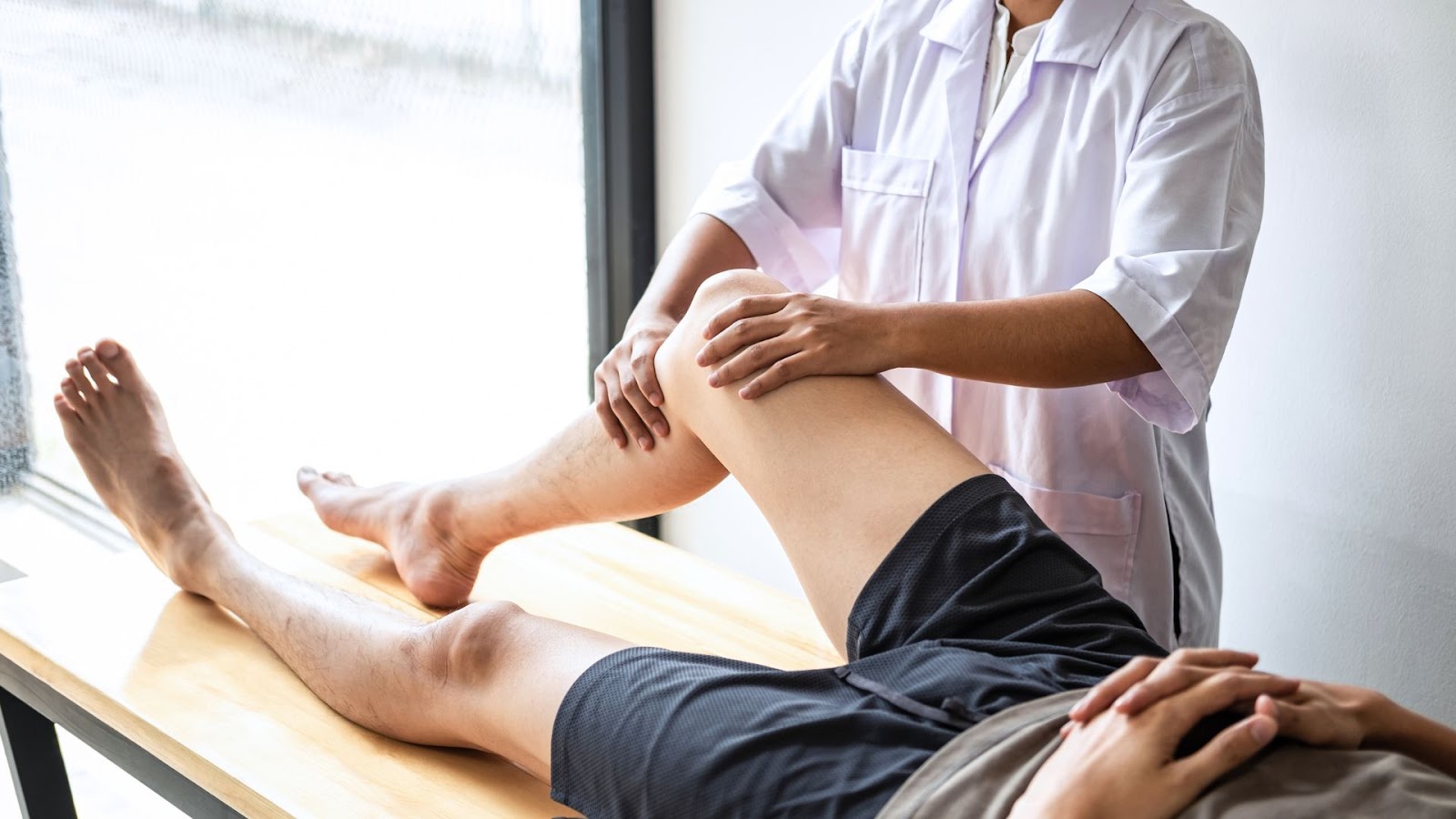To know if you have a medial collateral ligament (MCL) injury, pay attention to certain symptoms in your knee. You might feel pain on the inside of your knee, especially if you try to move it in certain ways. Swelling is another common sign that something might be wrong with your MCL.
Sometimes, everyday actions make MCL issues more noticeable. If your knee feels unstable or gives out when you stand, this could indicate an MCL injury. You may also hear a popping sound at the moment of injury. Recognizing these signs can help you decide whether you should see a healthcare professional for a proper diagnosis.
You should consider how the injury happened. MCL injuries often occur during sports or other activities involving sudden changes in direction or direct impact to the knee. If your injury occurred during such activities, this might give you a clue about the kind of injury you’re dealing with.

Visit Our Top Rated Physio Clinic in North Vancouver
Concerned about a knee MCL injury? Don’t let knee pain hold you back. At North Vancouver Physiotherapy & Sports Injury Clinic, our expert physiotherapists can assess your injury and develop a personalized treatment plan to get you back on your feet. Book your consultation today and start your recovery journey!
Recognizing Symptoms of an MCL Injury
Identifying an MCL injury involves looking for key symptoms such as pain, swelling, and knee instability. This section will guide you through these indicators to help determine if you might have an MCL injury.
Pain and Tenderness
Pain often occurs on the inner side of your knee if you have an MCL injury. You might notice an immediate sharp pain after an injury or a gradual ache over time. Pressing on the area might increase the discomfort.
You may experience this pain when twisting or bending your knee. Activities like walking, climbing stairs, or squatting can also cause pain. Tenderness can make it difficult to move your knee normally, and the area may feel warm to the touch.
Swelling and Stiffness
You might notice swelling around your knee after an MCL injury. This can occur soon after the injury or develop in the following days. Swelling may limit your ability to move your knee comfortably.
Stiffness is another symptom that can make your knee feel tight or difficult to bend. As a result, straightening your leg fully can be challenging. Ice packs and rest might help reduce swelling and stiffness in the affected area.
Instability or Difficulty Bearing Weight
Instability in your knee is a common sign of an MCL injury. You might feel that your knee is giving out or unable to support your weight. This can create challenges during everyday activities such as walking or standing.
Testing your knee by standing on one leg might reveal weakness or wobbliness. You may need to rely on support or avoid putting pressure on your injured knee altogether. These symptoms suggest that seeking medical advice is important to address the problem.
Diagnosis and Treatment
MCL injuries often require a proper evaluation to determine their extent and appropriate care. Treatment can involve medical evaluations, imaging, and varying levels of intervention.
Medical Evaluation
When you suspect an MCL injury, it’s important to see a healthcare professional. The doctor will likely check your knee for swelling, tenderness, and range of motion. They may ask how the injury happened and if you heard a pop.
Physical tests such as the Valgus Stress Test are also common. These help to assess the stability of your knee. Evaluations focus on pinpointing the injury’s severity so that the proper treatment can be planned effectively. Early diagnosis often leads to better recovery.

Surgical Interventions
In some cases, surgery is needed for severe MCL injuries. If there’s a complete tear or other complications with your knee, surgery might be necessary. The goal is to repair or reconstruct the ligament.
Surgical intervention involves stitching the ligament together. Sometimes, a graft is used to replace the damaged part. Surgery is usually followed by a rehabilitation program to restore knee function. It’s often done when other treatments don’t yield desired results. Always discuss the options with your healthcare provider.
Imaging Techniques
Imaging techniques help confirm the diagnosis of an MCL injury. X-rays can show if you have any bone issues like fractures. However, they don’t show soft tissues like ligaments well.
An MRI is more suitable here. It provides detailed images of your knee’s internal structures. This helps identify the condition of the ligaments and surrounding tissues. Imaging guides the healthcare provider in making informed decisions about your treatment plan.
Non-Intrusive Treatments
Conservative treatments focus on non-surgical methods to heal your MCL. Rest and ice are the first steps to manage pain and swelling. Use of a knee brace keeps the joint stable.
Physiotherapy is vital in non-intrusive treatment. Exercises help to strengthen muscles around the knee. This improves support and flexibility. A therapist will guide you through exercises designed to restore function safely. Recovery time varies, but compliance with the physiotherapy regimen can improve outcomes.
When following these treatments consistently, you can experience a noticeable improvement in your knee’s condition. Always use the guidance of a healthcare professional for best results.
Conclusion
If you suspect an MCL injury, pay attention to symptoms like pain, swelling, and difficulty moving your knee. Taking action quickly can help prevent further damage.
Rest and icing can reduce swelling and pain. Wearing a brace might provide support while your knee heals. Consult a healthcare professional for personalized guidance.
Exercises can improve strength and flexibility. Simple activities may aid recovery and prevent future injuries. Still unsure about your injury? Visit us at North Vancouver Physiotherapy & Sports Injury Clinic (Allied Physio). Our experts are ready to help you regain strength and confidence.